- 01: Introduction
- 02: History
- 03: Powder, Ammunition, and Firearm Development
- 04: Manufacture of Firearms
- 05: Small Arms Ammunition
- 06: Handling Procedures
- 07: Equipment and Instrumentation
- 08: Examination of Firearms
- 09: Cartridge and Shotshell Examination
- 10: Characterization and Evaluation of Fired Projectiles
- 11: Bullet Comparison and Identification
- 12: Gunshot Residue and Distance Determination
- 13: Toolmark Identification
- 14: Communicating Results
- Resources

Glossary
A : B : C : D : E : F : G : H : I : J : K : L : M : N : O : P : Q : R : S : T : U : V : W : X : Y : Z
| Note: |
| All glossary terms are from the AFTE glossary, the SAAMI glossary, Encyclopeadia Brittanica, or are supplied from subject matter experts unless stated otherwise. |
- ATop
- Abrasion Marks - See Toolmark, Striated
- Abrasive Machining - The use of abrasives rather than high-speed steel or tungsten carbide cutting tools.
- Acetic Acide - Chemical reagent used in Griess (Walker) test for gunpowder residue detection. Acetic acid forms nitrous acid in reacting with nitrites in gunpowder residues.
- Action - The working mechanism of a firearm. May be broken down into action types as follow.
- AUTOMATIC – A firearm design that feeds cartridges, fires, extracts and ejects cartridge cases as long as the trigger is fully depressed and there are cartridges in the feed system. Also called FULL AUTO and MACHINE GUN.
- BOLT – A firearm in which the breech closure:
- (1) Is in line with the bore at all times.
- (2) Manually reciprocates to load, unload, and cock.
- (3) Is locked in place by breech bolt lugs and
engaging abutments usually in the receiver. There are two principal types of bolt actions: the turn bolt and the straight pull.
- BOX LOCK – A design in which the hammer and hammer springs are located within the frame and the trigger assembly in the lower tang. Generally found on double-barrel shotguns, such as Parker, Fox, Stevens, Winchester Models 21 and 24, etc.
- FALLING BLOCK – A single shot lever action mechanism. The breechblock slides vertically or nearly vertically, when the lever is moved, to expose or lock the breech. Example: Ruger No. 1.
- HINGED FRAME – A design wherein the barrel(s) is pivoted on the frame. When the action is open, the barrel may pivot up, down, or sideways for loading or unloading. When the action is closed, the breech of the barrel(s) swings against the standing breech. Opening is normally accomplished by movement of a top-, side-, or under-lever.
- LEVER – A design wherein the breech mechanism is cycled by an external lever generally below the receiver.
- MARTINI – A hammerless single shot rifle action, lever operated, in which the movement of the breechblock is entirely within the receiver and pivots at the rear.
- REVOLVER – A firearm, usually a handgun, with a cylinder having several chambers so arranged as to rotate around an axis and be discharged successively by the same firing mechanism.
- ROLLING BLOCK – A single shot action in which a breechblock and hammer each rotate about their separate transverse pins in the receiver. The two members are swung rearward, away from the barrel breech to load the mechanism, or extract a cartridge case. To fire a cartridge, the breechblock is closed and locking is accomplished by the falling hammer engaging an abutment on the breechblock. Example: Remington No. 4.
- SEMIAUTOMATIC – A repeating firearm requiring a separate pull of the trigger for each shot fired, and which uses the energy of discharge to perform a portion of the operating or firing cycle (usually the loading portion).
- SIDELOCK – A design in which the firing mechanism is attached to a sideplate rather than being integral with the frame.
- SLIDE – An action which features a movable forearm which is manually actuated in motion parallel to the barrel by the shooter. Forearm motion is transmitted to a breech bolt assembly which performs all the functions of the firing cycle assigned to it by the design. Also known as PUMP ACTION.
- TRAP DOOR – An action in which a top hinged breechblock pivots up and forward to open. Locking on this action is accomplished by a cam located at the rear of the breechblock that fits into a mating recess. Also known as a CAM LOCK.
- Action, Turnbolt - A bolt action firearm on which it is necessary to rotate the bolt handle upwards for unlocking before it can be pulled to the rear. Similarly, it is necessary to rotate the bolt handle downward after closing to lock the firearm and enable the gun to be fired.
- Action Marks - Abrasion or scratches placed on a cartridge case or bullet through the mechanical function of loading or unloading a cartrige or pistol.
- Adapters - See Subcaliber Device
- AFTE Theory of Identification as it Relates to Toolmarks - 1. The theory of identification as it pertains to the comparison of toolmarks enables opinions of common origin to be made when the unique surface contours of two toolmarks are in "sufficient agreement."
2. This "sufficient agreement" is related to the significant duplication of random toolmarks as evidenced by the correspondence of a pattern or combination of patterns of surface contours. Significance is determined by the comparative examination of two or more sets of surface contour patterns comprised of individual peaks, ridges, and furrows. Specifically, the relative height or depth, width, curvature, and spatial relationship of the individual peaks, ridges, and furrows within one set of surface contours are defined and compared to the corresponding features in the second set of surface contours. Agreement is significant when it exceeds the best agreement demonstrated between toolmarks known to have been produced by the same tool. The statement that "sufficient agreement" exists between two toolmarks means that the likelihood another tool could have made the mark is so remote as to be considered a practical impossibility.
3. Currently the interpretation of individualization/identification is subjective in nature, founded on scientific principles and based on the examiner's training and experience. - Age hardening - Hardening with time by precipitation.
- Aggregate ball - A variant of ball propellant seldom encountered today, formerly used as a shotshell propellant. They are so named because each “apparent" granule is an aggregate of smaller balls. The size of these subparticles can vary by a factor of ten.
- Ammunition, Ball - One or more loaded cartridges consisting of a primed case, propellant, and with one or more projectiles. Also referred to as Fixed or Live Ammunition.
- Anvil - 1. An internal metal component in a boxer primer assembly against which the priming mixture is crushed by the firing pin blow. See PRIMER.
2. A metal feature in the primer pocket of a Berdan-primed cartridge case, against which the priming compound is crushed by the firing pin blow.
3. The breech end of the chamber in a rimfire firearm. - Anvil Marks - A term generally used by the military for a cartridge with a full metal jacketed bullet or solid metal projectile.
- Armor Piercing Bullets - See Bullet, Armor Piercing.
- Associative Evidence - Associative evidence can be used to provide links between evidence and individuals involved in a crime. In some cases, the associative evidence may be sufficient to prove the contact; in other cases, the associative evidence may be less definitive and provide corroboration of other evidence.
- Automatic - See ACTION, AUTOMATIC
- Azo Dye - A result of the Griess test in which nitrites from gunpowder residues are converted to an orange-red dye.
- BTop
- Backspatter - See Bullet splash.
- Ball powders - See POWDER, BALL.
- Ballistite - Trademark, applied to smokeless powder made of nitrocellulose dissolved in nitroglycerin (first made in 1888 and credited to Alfred B. Nobel, a Swedish chemist).
- Barrel blanks - An unfinished barrel in any state of completion.
- Barrel extension - A metal projection which extends rearward from the breech end of barrel into which the breech locks while the firearm is in battery or firing position. Example: Remington, Model 870.
- Barrel Swaging - The process of forming the interior and/or exterior shape of the barrel of a firearm by hammering. Also called HAMMER FORGING.
- Barrel Vent - An opening or series of openings in a barrel, normally near the muzzle, through which gases pass prior to bullet exit.
- Battery Cup - A flanged metallic cup used in shotshell primer assemblies that provides a rigid support for the primer cup and anvil. Also called BATTERY POCKET.
- Bearing Surface - That portion of a bullet's outer surface that comes into direct contact with the interior surface of the barrel.
- Bench Block - Usually hardened steel that has been worked and altered to serve a particular purpose. The gunsmith's block has holes and channels cut into it that facilitate the disassembly of a firearm when used in conjunction with drifts and hammers.
- Bird shot - See SHOT, BIRD.
- Black powder - See Powder, Black
- Blanking - Cutting or pressing a piece of metal from a sheet. Imagine an office hole punch made to handle steel metal. In ammunition manufacture, the usable part of a blanking operation is the material removed from the hole, usually a disk.
- Blowback -
1. In firearms, an automatic or semiautomatic firearm design that directly utilizes the breech pressure exerted on the head of the cartridge case to actuate the mechanism.
2. In ammunition, a leakage of gas rearward between the case and the chamber wall from the mouth of the case. See also BLOWBACK, DELAYED. - Blowback, delayed - A system in which the breechblock is not locked but some mechanical delay is incorporated to ensure that the breechblock cannot move back with sufficient rapidity to allow the unsupported case to emerge from the chamber while the pressure is still high. Also known as RETARDED BLOWBACK.
- Blowby - 1. The escaping of gases past the bullet, while the bullet is in the barrel.
2. A slang term for "Blowback." - Bolt - That portion of a lock which is moved into a locked or unlocked position, mechanically or electrically.
See also:
1. See BREECH BOLT.
2. See CYLINDER STOP.
3. See LATCH. - Bolt action - See ACTION, BOLT.
- Bolt face - See BREECH FACE.
- Bore Diameter - 1. Rifled barrels; the minor diameter of a barrel which is the diameter of a circle formed by the tops of the lands.
2. Shotguns: the interior dimensions of the barrel forward of the chamber but behind the choke. - Boring - Producing smooth and accurate holes in a workpiece by enlarging existing holes with a bore, which may bear a single cutting tip of steel, cemented carbide, or diamond or may be a small grinding wheel.
- Borescope - An instrument for examining the bore and chamber of a firearm. It usually consists of a tube, mirror, light source, and the lens that can be inserted into the chamber or muzzle.
- Bottleneck cartridge - See CARTRIDGE, BOTTLENECK.
- Box magazine - A rectangular receptacle attached to or inserted into a firearm that holds cartridges stacked on top of one another ready for feeding into the chamber.
- Bracketing - This is a technique to ensure correct exposure of photographs. This is achieved by taking two additional photographs – one slightly underexposed and another slightly overexposed.
- Breech face - That part of the breechblock or breech bolt which is against the head of the cartridge case or shotshell during firing.
- Breech-face marks - Marks characteristic of the breech under the firing pin and have been used to identify a cartridge case with a specific firearm. That part of the breechblock or breech bolt which is against the head of the cartridge case or shotshell during firing.
- Breech bolt - The locking and cartridge head support mechanism of a firearm that operates in line with the axis of the bore.
- Breech loading - A breech-loading weapon is a firearm (a rifle, a gun etc.) in which the bullet or shell is inserted or loaded at the rear of the barrel, or breech; the opposite of muzzle loading.
- Breechblock - The locking and cartridge head support mechanism of a firearm that does not operate in line with the axis of the bore.
- Breech-face markings - Negative impression of the breech face of the firearm found on the head of the cartridge case and/or primer after firing. Also see MATRIX
- Broaching - Finishing surfaces by drawing or pushing a cutter called a broach entirely over and past the surface. A broach has a series of cutting teeth arranged in a row or rows, graduated in height from the teeth that cut first to those that cut last.
- Buckshot - Lead pellets ranging in size from .20" to .36" diameter normally loaded in shotshells.
- Bulk propellants - "Noncanister" propellants are sold in bulk to ammo manufacturers who have pressure testing equipment.
- Bullet, Armor Piercing - 1. A bullet consisting of a hardened core or wholly composed of a substance other than lead or lead alloy.
2. Any bullet manufactured, represented, or designed to be metal or armor piercing. - Bullet, Boattail - A specific design of bullet having a tapered or a truncated conical base.
- Bullet, Brass Washed - A term used for lead bullets with a brass-colored coating. Sometimes referred to as GOLDEN BULLETS. This coating has been used on 22 rimfires by manufacturers in the USA, Australia, Mexico, Austria, and the Philippines.
- Bullet, Capped - Consists of a standard lead bullet having a harder metal jacket (gliding metal, copper, etc.) over the nose. Also known as METAL POINT BULLET.
- Bullet, Cast - A bullet formed by pouring molten lead into a mold.
- Bullet, Coated - Lead alloy bullet having a thin metal alloy coating. Examples: R/P “Golden Bullet" and W/W “Lubaloy."
- Bullet, Conoidal - A cone-shaped bullet. Also known as a conical bullet.
- Bullet, Copper Jacketed - A bullet having an outer jacket of copper or copper alloy and containing a lead alloy core.
- Bullet, Copper Washed - A term used for lead bullets with a copper-colored coating. This finish is found extensively on 22 rimfire cartridges from manufacturers around the world.
- Bullet, Disintegrating - See BULLET, Frangible.
- Bullet, Dumdum - An obsolete term referring to an expanding bullet manufactured at the British Arsenal in Dumdum, India.
- Bullet, Expanding - See BULLET, MUSHROOM.
- Bullet, Exploding - A bullet containing a primer or other explosive and designed to explode upon impact.
- Bullet, Flat-nosed - A bullet with flattened tip at right angles to its axis. See MEPLAT.
- Bullet, Frangible - A projectile designed to disintegrate upon impact with a hard surface in order to minimize ricochet.
- Bullet, Full Metal Case - See BULLET, FULL METAL JACKET.
- Bullet, Full Metal Jacket - A projectile in which the bullet jacket encloses the entire bullet, with the usual exception of the base. Also called FULL JACKETED, FULL PATCH, FULL METAL CASE and BALL AMMUNITION.
- Bullet, Gallery - See BULLET, FRANGIBLE.
- Bullet, Gas Check - A lead alloy bullet with a copper or gilding metal cup pressed over the base.
- Bullet, Gas Cutting - See GAS CUTTING.
- Bullet, Hollow Base - A bullet with a deep base cavity.
- Bullet, Hollow Point - A bullet with a cavity in the nose to facilitate expansion.
- Bullet, Incendiary - A bullet containing a chemical compound which ignites upon impact to start fires.
- Bullet, Inside Lubricated - A bullet having cannelures containing lubrication which are covered when seated in the cartridge case.
- Bullet, Jacketed - See BULLET, COPPER JACKETED.
- Bullet, Land and Groove Impressions - See LAND AND GROOVE IMPRESSIONS.
- Bullet, Lead - A bullet formed from a lead alloy.
- Bullet, Metal - An alloy of lead, antimony, and/or tin.
- Bullet, Metal Cased - See BULLET, FULL METAL JACKET.
- Bullet, Metal Cased Hollow Point - A bullet having a metal jacket enclosing a lead alloy core. The entire bullet is enclosed except for the nose which has a cavity.
- Bullet, Mushroom - A bullet that has expanded upon impact to a mushroom-like shape, or designed to so expand.
- Bullet, Ogive - The curved forward part of a bullet.

- Bullet, Open Point Expanding - See BULLET, HOLLOW POINT.
- Bullet, Outside Lubricated - A lead bullet lubricated on the surface not covered by the cartridge case.
- Bullet, Partition - A bullet designed for controlled expansion having a jacket which is divided into two chambers which enclose the forward and rear cores of the bullet. It is designed so that the first chamber expands and the rear chamber holds together for penetration.
- Bullet, Plated - See BULLET, COATED.
- Bullet, Round Nose - An elongated projectile with a radiused nose. Technically, the radius of the nose is one-half of the bullet's diameter.
- Bullet, Semijacketed Hollow Point - A bullet with a partial jacket exposing a lead nose with a cavity.
- Bullet, Semiwadcutter - A projectile with a distinct, short truncated cone at the forward end.
- Bullet, Soft Point - A design providing for exposure of a portion of the core at the nose of a jacketed bullet.
- Bullet, Solid Base - Composed of one material with no jacketing.
- Bullet, Spire Point - A projectile with a conical nose profile.
- Bullet, Spitzer - A bullet design having a sharp point, long ogive, usually of seven calibers or more (i.e., ogive radius length to bullet diameter).
- Bullet, Steel Jacketed - A bullet with steel used as jacket material.
- Bullet, Swaged - A bullet that has been formed by compressing and forming the bullet material in a die.
- Bullet, Tracer - A bullet that has a burning compound in its base which permits observation of its flight.
- Bullet, Truncated - A design of a flat-nosed bullet having a conical, rather than rounded, nose.
- Bullet, Wadcutter - A cylindrical bullet design having a sharp-shouldered nose intended to cut target paper cleanly to facilitate easy and accurate scoring.
- Bullet, Wax - A bullet made from paraffin and/or other wax preparations, usually used for short-range indoor target shooting.
- Bullet, Wooden - 1. A projectile made of wood.
2. A projectile made of hollow wood which will disintegrate in the bore or a short distance from the muzzle. Many European blanks are loaded with wooden bullets to facilitate feeding. - Bullet Core - The inner portion of a jacketed bullet, usually lead.
- Bullet Penetration - The distance which a bullet travels in a target material.
- Bullet Recovery System - Any method which will allow the undamaged recovery of a fired bullet. Differing systems are needed for different cartridges depending upon bullet composition, jacket thickness, and velocity. Water tanks and cotton boxes are most commonly in use.
- Bullet Splash - The spatter and fragmentation of a bullet upon impacting a hard surface.
- Bullet Wipe - The discolored area on the immediate periphery of a bullet hole, caused by bullet lubricant, lead, smoke, bore debris, or possible jacket material. Sometimes called BURNISHING or LEADED EDGE.
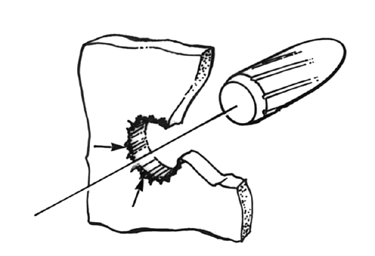
- Bunter - The die which produces the headstamp on rimfire cartridge cases or the headstamp and primer pocket on centerfire cartridge cases.
- CTop
- Calipers - A device consisting of two moveable legs or jaws, used to measure diameter, thickness, or distance between two surfaces.
- Canister Propellant - Propellant offered to individual consumers for loading small arms ammunition.
- Cannelure - A circumferential groove generally of a knurled or plain appearance in a bullet or cartridge case. Three uses include crimping, lubrication, and identification.
- Capped Bullet - See Bullet, Capped.
- Card Wad - See Wad, Card.
- Cartridge - A single unit of ammunition consisting of the case, primer, and propellant with one or more projectile(s). Also applies to a shotshell.
- Cartridge, bottleneck - A cartridge case having a main diameter and a distinct angular shoulder stepping down to a smaller diameter at the neck position of the case.
- Cartridge, Centerfire - Any cartridge that has its primer central to the axis in the head of the case.
- Cartridge, Definitive Proof - A cartridge loaded to specified pressures higher than service loads which is used for testing assembled firearms and breech bolts, receivers, and barrels sold as firearm components.
- Cartridge, Provisional Proof -A cartridge loaded to specified pressures higher than service loads to test firearm barrels during manufacture, but before assembly. Sometimes called BLUE PILL.
- Cartridge, Rimfire - A flange-headed cartridge containing the priming mixture inside the rim cavity.
- Case Head - The base of the cartridge case which contains the primer.
- Cast - See Casting.
- Casting -
1. An object at or near finished shape which is produced by solidification of a substance in a mold.
2. Pouring molten metal into a mold to produce an object of desired shape. - Celluloid - The name of a class of compounds created from nitrocellulose and camphor, plus dyes and other agents.
- Cellulose - The chief part of the cell walls of plants; occurs naturally in such fibrous products as cotton and kapok, and is the raw material of many manufactured goods (as paper, rayon, and cellophane).
- Centerfire - See Cartridge, Centerfire.
- Chamber - The rear part of the barrel bore that has been formed to accept a specific cartridge. Revolver cylinders are multichambered.
- Chamber Marks - Individual microscopic marks placed upon a cartridge case by the chamber wall as a result of any or all of the following: (1) chambering, (2) expansion during firing, (3) extraction.
- Chamber throat - That area forward of the cartridge chamber, extending to the point of full bore diameter. Also known as LEADE or THROAT. See also FORCING CONE.
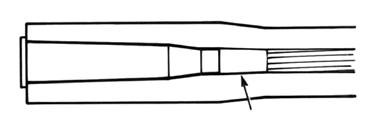
- Chambering - 1. The reaming out of a chamber in the end of a barrel blank or cylinder.
2. The act of inserting a cartridge in the chamber. - Chemical Machining - This nonelectrical process removes metal from selected or overall areas by controlled chemical action. Two types of chemical machining processes include chemical blanking, which is used for cutting blanks of thin metal parts, and chemical milling, which is used for removing metal from selected or overall areas of metal parts.
- Chips - The metal removed during certain machining processes such as turning, drilling, boring, and shaping.
- Choke - An interior constriction at or near the muzzle end of a shotgun barrel bore for the purpose of controlling shot dispersion.
- Chronograph - An electronic device used to measure and record the velocities of projectiles.
- Class Characteristics - Measurable features of a specimen which indicate a restricted group source. They result from design factors, and are therefore determined prior to manufacture.
- Climb - Mill turn causes teeth to cut against travel, mill tooth cuts "down" through the work, the direction of cutter rotation is same as the feed motion. For example, if the cutter rotates counterclockwise , the workpiece is fed to the right in down milling.
- Coated - The art of applying wood, metal, plaster, glass, or other objects with a covering of metal in leaf or powder form, including gold, silver, palladium, aluminum, and copper alloys.
- Coated Bullet - See Bullet, Coated.
- Cock - To place a firing mechanism under spring tension.
- Coining Die -Die used in the process of machining a cavity in a steel block to be used for molding plastics, or for hot and cold forging.
- Collet - A metal band, collar, ferrule, or flange as
(1) a casing or socket for holding a tool (as a drill bit)
(2) a circle or flange in which a gem is set. - Combination Wad - See Wad, Combination.
- Commercial Bronze - Otherwise known as brass, 90 percent copper and 10 percent zinc, and contains no tin. It is stronger than copper and it has equivalent ductility.
- Comparison Microscope - Essentially two microscopes connected to an optical bridge which allows the viewer to observe two objects simultaneously with the same degree of magnification. This instrument can have a monocular or binocular eyepiece. Sometimes referred to as a COMPARISON MACROSCOPE.
- Compound Microscope - A microscope consisting of an objective and an eyepiece mounted in a drawtube.
- Confocal - Two microscopes are used to examine the same region of an object from opposite sides of the object. A small illuminated aperture is focused onto the object by the illuminating microscope. The receiving microscope is configured identically, with a photodetector following a small aperture in the magnified focal plane of the receiving microscope. The two microscopes are adjusted to focus on the same region in space. This effectively prevents any extraneous light or any light scattered at the confocal image region from reaching the detector. The object is then scanned to build up an image from the detected signal.
- Conical Bullet / Conoidal Bullet - See Bullet, Conoidal.
- Controlled Expansion - When the first chamber of a jacketed bullet expands and the rear chamber holds together for penetration.
- Convex - A convex lens is a circular or spherical surface. A lens with a convex surface on one side and plane surface on the other is called a plano-convex lens. One with convex surfaces on both sides is known as bi-convex, or sometimes simply convex lens.
When an incident ray crosses a convex border, it is refracted as defined by Snell's Law. Assuming the lens material is denser than the source medium, the ray will refract towards the normal. As the refracted ray exits the lens on the other convex side, it is once again refracted, this time away from the normal as it is entering a less dense medium. From http://trueforce.com/Optics/Convex.htm - Copper or Brass Plated/Washed - See Bullet, Copper Washed and Bullet, Brass Washed.
- Copper Washed - See BULLET, COPPER WASHED.
- Cordite - A double-base smokeless powder made of gun cotton, nitroglycerin, and mineral jelly and shaped in long cylindrical strands.
- Core - See Bullet Core.
- Correlations - A process whereby two image segments are compared to determine their similarity, or to find the position at which optimal similarity exists. The two images are called the WINDOW and the TEMPLATE or GOLDEN IMAGE. Applications of correlation include target tracking, defect detection, and stereo correspondence. Also, the term is used to define the automatic comparison of bullets.
- Crimping - The closure of the mouth of a shotshell by one of a number of crimping techniques.
- Crimp, rolled - The closure of the mouth of a shotshell by inverting the mouth of the tube over a top wad or slug.
- Cup Wad - See Wad, Cup.
- Cupping - A combination of extrusion and swaging used to produce a cup-shaped piece of metal. The resulting cup can be used to make a bullet jacket or cartridge case. The disks are blanked from sheet stock and passed immediately into a die stack. The die(s) produces the proper outside dimension and a punch produces the inside diameter.
- Cupping Press - Machine that cuts circular discs from a metal sheet and forms them into cups.
- Cut Rifling - Cut rifling creates spiral grooves in the barrel by removing steel using some form of cutter.
- Cylinder - The rotatable part of a revolver that contains the chambers.
- Cylinder stop - A device to stop cylinder rotation in proper alignment with the barrel of a revolver.
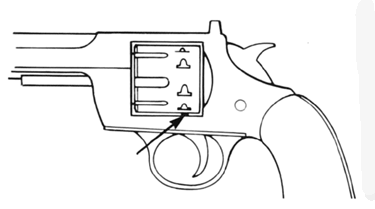
- Cylindrical Propellants - See Powder, Tubular
- DTop
- Double-Action Only (DAO) - A double-action only is similar to a double-action revolver trigger mechanism; however, there is no single-action function. For semiautomatic pistols with a traditional hammer, the hammer will return to its decocked position after each shot. For striker-fired pistols, such as the Taurus 24/7, the striker will remain in the rest position through the entire reloading cycle. This term applies mostly to semiautomatic handguns; however the term can also apply to some revolvers such as the Smith & Wesson Centennial revolver.
- Deposition - Testimony taken down in writing under oath.
- Dial Press - Machine that rotates on a horizontal plane.
- Die - Tool or device for imparting a desired shape, form, or finish to a material; examples include a perforated block through which metal or plastic is drawn or extruded.
- Die Extrusion - Extrusion, one of the forming techniques used in material processing, consists of forcing the workpiece through a die, thereby reducing its cross section and increasing its length. Usually, there is no loss of the extruded material, except in some special cases.
- Disconnector - A device to prevent a semiautomatic firearm from firing full automatic. Some pump action shotguns also have disconnectors.
- Disk Propellants - An extruded form of smokeless powder cut into thin circular discs which may have a central perforation according to the manufacturer's choice. Such propellants are most commonly used in pistol and shotgun ammunition and may be of either single- or double-base formulation. Examples: DuPont PB, Hi Skor 700X, SR7625, Hercules, Bullseye, Unique, and Red Dot.
- Disposition - Documentation of status of evidence including location.
- Double-based Propellants - A solid propellant consisting of two monopropellants, usually nitroglycerin and nitrocellulose, and various additives; used as smokeless powders in ammunition.
- Drawing - A process using dies and punches to simultaneously reduce the diameter and extend the length of a cup-shaped metal part. Used for both cartridge cases and bullet jackets.
- Drill bit - a rod with a sharp working edge at one end.
- Drilling - Cutting holes in metal with a twist drill. Drills also use a variety of other cutting tools to perform the following basic hole-machining operations: (1) reaming, (2) boring, (3) counterboring, (4) countersinking, and (5) tapping internal threads with the use of a tapping attachment.
- Drop Forging - A wrought piece formed hot between dies under a drop hammer, or by pressure.
- Drop Shot - See Shot, Drop.
- Dummy Ammunition - An inert cartridge which cannot be fired.
- ETop
- Ejecta - Material thrown out.
- Ejection - The act of expelling a cartridge case from a firearm.
- Ejection Port Marks - Striated marks produced by hard contact between the ejection port of a firearm and a rapidly moving ejected cartridge case.
- Ejector - A portion of a firearm's mechanism which ejects or expels cartridges or cartridge cases from a firearm.
- Ejector Marks - Toolmarks produced upon a cartridge case on the head, generally at or near the rim, from contact with the ejector.

- Electron Beam Machining (EBM) - Technique for cutting fine holes and slots in any material. In a vacuum chamber, a beam of high-velocity electrons is focused on a workpiece. The kinetic energy of the electrons, upon striking the workpiece, changes to heat, which vaporizes minute amounts of the material. The vacuum prevents the electrons from scattering, due to collisions with gas molecules.
- Electrical Discharge Machining (EDM) - EDM involves the direction of high-frequency electrical spark discharges from a graphite or soft metal tool, which serves as an electrode, to disintegrate electrically conductive materials such as hardened steel or carbide. The electrode and workpiece are immersed in a dielectric liquid, and a feed mechanism maintains a spark gap of from 0.0005 to 0.020 inch (0.013 to 0.5 millimetre) between the electrode and the workpiece. As spark discharges melt or vaporizes small particles of the workpiece, the particles are flushed away and the electrode advances.
- Electrochemical Machining (ECM) - ECM resembles electroplating in reverse. In this process metal is dissolved from a workpiece with direct current at a controlled rate in an electrolytic cell.
- End Mill - A cutter shaped like a pencil with a tapered shank that fits into the machine spindle; it has cutting teeth on its face and spiral blades on the lateral surface.
- End Milling - The cutter in end milling generally rotates on an axis vertical to the workpiece. It can be tilted to machine tapered surfaces. Cutting teeth are located on both the end face of the cutter and the periphery of the cutter body.
- Etching - A process in which lines or textures are bitten (etched) into a metal plate with a variety of mordants (acids).
- Exploding Bullet - A bullet containing a primer or other explosive and designed to explode upon impact.
- Extractor - A mechanism for withdrawing the cartridge or cartridge case from the chamber.
- Extraction - The act of withdrawing a cartridge or cartridge case from the chamber of a firearm.
- Extrusion - The slow forcing of material under high pressure through a die to reduce its diameter. This process is generally performed in a hydraulic press. Lead wire used in bullet making is extruded. A subset of extrusion is impact extrusion. Impact extrusion uses a fast strong blow rather than slow pressure to form a metal part in a closed-bottom die. Impact extrusion can be used to make bullet jackets and cartridge cases.
- Eyepiece - The lens or combination of lenses nearest the eye of the viewer in an optical instrument. Also referred to as an OCULAR.
- Eyepiece Micrometer - See Micrometer, Eyepiece.
- FTop
- Face Milling - In face milling, the cutter is mounted on a spindle having an axis of rotation perpendicular to the workpiece surface. The milled surface results from the action of cutting edges located on the periphery and face of the cutter.
- Falling Block - See ACTION, FALLING BLOCK.
- Feed lips - See Feed Throat.
- Feed Throat - A component which guides a cartridge from the magazine to the chamber.
- Feeding - The insertion of cartridges into the chamber; the breech bolt pushes the cartridge into final position
- Feet per Second - The unit of measurement used to express the speed of a projectile. Abbr.: fps.
- Filler Wad - See Wad, Filler.
- Fine blanking - A cold forming process for high-volume production of precision components.
- Fine Forming - Hand or machine process to give final form to an object through methods such as polishing or grinding
- Firearms Function Testing -The examination of a firearm concerning its mechanical condition and operation. It is usually performed to determine if all safety features are operable and/or if the firearm is capable of firing a cartridge.
- Firearms Identification - A discipline of forensic science which has as its primary concern to determine if a bullet, cartridge case, or other ammunition component was fired by a particular firearm.
- Firing - When the breech is fully locked, a pull on the trigger mechanically translates to the firing pin release.
- Firing Pin Drag Marks - The toolmarks produced when a projecting firing pin comes into contact with a cartridge case or shotshell during the extraction, ejection cycle.
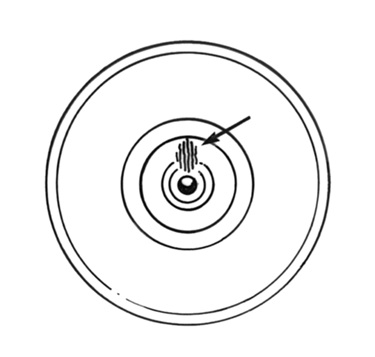
- Firing Pin Hole - The aperture in the breech face through which the firing pin protrudes.
- Firing Pin Impression - The indentation of the primer of a centerfire cartridge case or in the rim of a rimfire cartridge case caused when it is struck by the firing pin.
- Fixed Ammunition - A cartridge comprised of a cartridge case, primer, propellant powder, and projectile(s).
- Flame annealed - To soften a metal piece and remove internal stresses by heating to its critical temperature and allowing it to cool slowly.
- Flash Hole -
1. A hole(s) pierced or drilled through the web in the primer pocket of a metallic cartridge case.
2. The hole in the end of a battery cup primer used in shotshells.
3. The hole in a percussion nipple. - Flat-bladed Prying Tool - A tool with a flat surface which is capable of prying open a door or cover, such as a crowbar, screwdriver, tire iron, etc., or any of a variety of homemade or modified tools.
- Flat-nosed Bullets - See Bullet, Flat-nosed
- Flattened Ball Powders - See Powder, Ball
- Flintlock -
An improvement upon previous firing mechanisms (such as snaphaunce). Major improvement was the addition of a frizzen, which combined the functions of a priming pan cover and an anvil into a single unit.
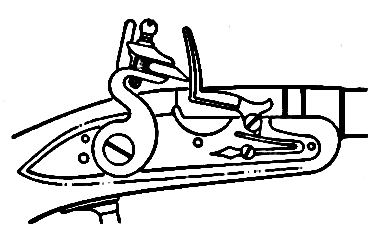
- Foil Paper - A thin paper cover between the compound and the anvil; prevents wet priming compound from sticking to compaction pins during assembly. The paper is nitrated and undergoes virtually complete combustion when the primer burns; the name is derived from original percussion caps that had a layer of foil over the mix for protection
- Follower - A locksmith's tool which holds the driver pins and the springs in the cylinder housing while the plug is being removed.
- Forcing Cone - The tapered section at the front end of a shotgun chamber by which the diameter of the front end of the chamber is reduced to bore diameter. A forcing cone is also present in the breech end of most revolver barrels.
- Forged rifling - A mechanical method of rifling barrels by means of external hammering
- Forging - To shape metal while hot and plastic by hammering or by a forcing process, either by hand or by machine.
- Forging, Hand - See Forging.
- Forging, Machine - See Forging.
- Fouling - The residual deposits remaining in the bore of a firearm after firing. Fouling can change the character of the identifiable striations imparted to the projectile from one shot to another. See LEADING.
- Fracture Matches - See Physical Match.
- Frame - The receiver, also known as the frame, the basic component of a firearm to which all other components are assembled or attached. In most firearm designs the barrel is assembled to the receiver and the receiver houses the breech mechanism, trigger, and firing mechanisms.
- Frangible - See BULLET, FRANGIBLE.
- Friction Marks - See Striations.
- Frizzen - A combination of a priming pan cover and an anvil. When the trigger is pulled, a spring action causes the cock to strike the frizzen, showering sparks onto the gunpowder in the priming pan; the ignited powder, in turn, fires the main charge in the bore, propelling the ball.
- Full metal jacket bullet - See Bullet, Full Metal Jacket.
- Full Patch - See Bullet, Full Metal Jacket.
- Fulminate of Mercury - A highly corrosive component of a priming compound.
- GTop
- Gas Check - See Bullet, Gas Check.
- Gas cutting -
1. An erosive effect in a firearm caused by the high-velocity, high-temperature propellant gases.
2. The erosion that occurs from the hot gases on the bearing surface and base of a fired bullet. - Gas port - An opening in the wall of a barrel to allow gas to operate a mechanism or reduce recoil.
- General Rifling Characteristics (GRC) - The number, width, and direction of twist of the rifling grooves in a barrel of a given caliber firearm.
- Gilding Metal - Metal alloys of 90 or 95 percent copper and the remainder zinc. Also termed COMMERCIAL BRONZE. Neither name is recommended by Cooper Development Association, Inc., but instead Alloy No. 220 and Alloy No. 210 respectively are recommended. It is used extensively for the manufacture of bullet jackets.
- Granules - The individual particles of propellant powder. Also see KERNELS.
- Griess Test - A chemical test for the detection of nitrites. It is used by the firearms examiner to develop patterns of gunpowder residues (nitrites) around bullet holes.
- Groove - See RIFLING.
- Groove Diameter - The major diameter of a barrel which is the diameter of a circle circumscribing the bottom of the grooves in a rifled barrel.
- Gross forming - Machining process to give general form and shape to an object through methods such as casting or forging.
- Gunpowder - Any of various powders used in firearms as a propellant charge.
- Gunshot Residues - The total residues resulting from the discharge of a firearm. It includes both gunpowder and primer residues, plus metallic residues from projectiles, fouling, etc.
- HTop
- Hammer - A component part of the firing mechanism which gives impulse to the firing pin or primer.
- Hammer-forging - See BARREL SWAGING.
- Hand-forging - The hammering of a metal part into shape.
- Header - Top cross member of the door frame.
- Heading operation - Metal-forging process used for rapidly producing enlarged (upset) sections on a piece of rod or wire held in a die.
- Headspace - The distance from the face of the closed breech of a firearm to the surface in the chamber on which the cartridge case seats.
- Headstamp - Numerals, letters and symbols (or combination thereof) stamped into the head of a cartridge case or shotshell to identify the manufacturer, caliber, gauge or give additional information.
- Heeled bullet - A heeled bullet is an archaic design of bullet where the internal diameter of the barrel is the same diameter as the cartridge case, and the bullet has a step at the rear to allow it to fit inside the case. Heeled bullets mostly disappeared with the advent of smokeless powder cartridges, though older rimfire designs still use heeled bullets, and many cartridges that date back to the black powder era still reflect their heeled bullet origins in their caliber designations. From http://en.wikipedia.org/wiki/Heeled_bullet
- Hydrodynamic Machining (HDM) - A process employing a high pressure, fine stream of liquid at pressures up to 414 MPa (60,000 psi) for material removal or for cutting action.
- ITop
- Impact extrusion - In impact extrusion (also called back-extrusion), the workpiece is placed in the bottom of a hole (the die), and a loosely fitting ram is pushed against it. The ram forces the metal to flow back around it, with the gap between the ram and the die determining the wall thickness.
- Impressions - Surface contour variations on an object caused by applying force without motion, or where the motion is approximately perpendicular to the plane being marked.
- Incendiary Bullets - See Bullet, Incendiary.
- Indexing - 1. The rotation and stopping of a revolver cylinder.
2. A method for marking cartridges and bullets to orient the position of test cartridges in the firearm. - Individual Characteristics - Marks produced by the random imperfections or irregularities of tool surfaces. These random imperfections or irregularities are produced incidental to manufacture and/or caused by use, corrosion, or damage. They are unique to that tool and distinguish it from all other tools.
- Inertia bullet puller - A tool using impact to remove a bullet from a cartridge case.
- Intercomparison - Comparison of two evidence items to determine similarities and individuality to establish linkage, if possible, by use of a comparison microscope. For example: two different bullets or cartridge cases
- Interior ballistics - The study of the motion of the projectile(s) within the firearm from the moment of ignition until it leaves the barrel.
- Investment casting (IC) - Casting metal into a mold produced by surrounding (investing) an expendable pattern with a refractory slurry that sets at room temperature after which the wax, plastic, or frozen mercury is removed though the use of heat. Example: the manufacture of Ruger revolver frames. Also called PRECISION CASTING or LOST WAX PROCESS.
- In Phase - In a correlated or synchronized way.
- JTop
- Jacketed Bullets - See Bullet, Copper Jacketed
- Jacketed Hollow Point Bullets - See Bullet, Metal Cased Hollow Point.
- Jacketed Solid Base - Jacketed bullet with the core enclosed.
- KTop
- Kernels - The term preferred by SAAMI for an individual particle of any of the various forms of smokeless powder or the various granulations of black powder. Also see GRANULES.
- Known Standards -A collection and cataloging of test-fired bullets and cartridge cases from known firearms. Also known as FIRED STANDARDS.
- LTop
- Laboratory Information Management Systems - Electronic laboratory tracking systems that permit integration of analysis data with chain-of-custody information.
- Lamelle - Cut sheet or Lamelle propellant is stamped out (die-cut) from sheets of nitrocellulose.
- Land - The raised portion between the grooves in a rifled bore.
- Land and Groove Impressions - The negative impressions on the bearing surface of a bullet caused by the rifling in the barrel from which is was fired.
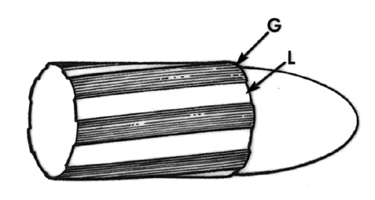
- Lapping - The process of polishing a metal surface such as the interior of a barrel with a fine abrasive substance to remove toolmarks and pits.
- Laser Machining - A method of cutting metal or refractory materials by melting and vaporizing the material with an intense beam of light from a laser.
- Latch - A moveable device used to secure a part or piece in place relative to another. As applied to firearms, various types of latches are employed to hold barrels, cylinders, etc., in position during firing and to enable these parts to be moved for loading and unloading.
- Lathe - A machine tool for shaping metal or wood.
- Lead Azide - A chemical compound used in priming mixtures.
- Leading - The accumulation of lead or bullet jacket material in the bore of a firearm from the passage of lead shot or bullets.
- Lead Bullet - A bullet formed by a lead alloy.
- Lead Styphnate - Also known as Trinitrosesorcinate. A percussion sensitive initial detonating agent which is used in priming mixtures.
- LIMS - Laboratory Information Management System.
- Lock - 1. A general term referring to the total firing mechanism of a firearm.
2. The action, either manual or automatic, of locking or supporting the bolt of a firearm immediately prior to firing. - Lock plate - A metal plate mounted on the stock of a firearm to provide for mounting of, or access to, the firing mechanism.
- Long recoil - A system in which the bolt and barrel recoil a greater distance than the length of the unfired cartridge. The breechblock is then held to the rear while the barrel is driven forward by its own spring. When the barrel is fully forward, it trips the catch releasing the breechblock, which then feeds the next cartridge into the chamber.
- Lug - One or more projectiles from the breech bolt which serve to lock it into place when closed. Also called a BOLT LUG, which may or may not be an integral part of the breech bolt.
- MTop
- Machine forging - See Forging.
- Machine gun - 1. A fully automatic firearm that loads, fires, and ejects continuously when the trigger is held to the rear until the ammunition is exhausted or pressure on the trigger is released.
2. To Machine Gun: Also known as Firing Full-Automatic. - Machining - A process in which a sharpened metal tool or abrasive surface refines and removes metal to achieve a desired form and dimension.
- Machinists Scale - Measuring device using thousandths of an inch as a unit measure.
- Magazine - 1. A container for cartridges which has a spring and follower to feed those cartridges into the chamber of a firearm. The magazine may be detachable or an integral part of the forearm.
-
A. BLIND BOX – An integral magazine having a permanently closed bottom. Loading and unloading are accomplished through the same opening.
B. BOX – A rectangular receptacle attached to or inserted into a firearm that holds cartridges stacked on top of one another ready for feeding into the chamber.
C. DETACHABLE – Any of a large array of magazines which are removable from the firearm for reloading.
D. DRUM – A drum shaped magazine in which the cartridges are arranged spirally around the central axis of the wind-up mechanism of the magazine. These were generally large-capacity magazines, being used most commonly on submachine guns. Examples: Thompson submachine gun, Luger, Russian PPSH, and Degtyarov machine guns.
E. ROTARY – A form of magazine in which the cartridges are arranged about a central rotating spindle or carrier. Examples: Savage Model 99 and Mannlicher rifles.
F. STAGGERED COLUMN – A box magazine which, rather than having a single column of cartridges, has two columns staggered. This increases the capacity without lengthening the magazine. Examples: Browning Hi-Power and S&W Model 59.
G. TUBULAR – A tube-shaped magazine in which the cartridges are arranged end-to-end. It may be either under the barrel or in the butt stock.
-
A. BLIND BOX – An integral magazine having a permanently closed bottom. Loading and unloading are accomplished through the same opening.
- Magazine Marks - Striated marks produced on the periphery of a cartridge as it moves from the lips of a magazine towards the chamber during feeding.
- Magnifying Power - The ratio of apparent size of an object viewed through an optical instrument to its actual size, i.e., 4X means the object would appear four times larger.
- Major Diameter - The groove diameter.
- Mandrel - 1. A tool with sharpened opposing jaws which cut with a pinch-pinching action, such as a pair of bolt cutters. Also called PINCHING TOOL.
2. A metal rod or bar used as a core around which metal, wire, etc., is cast, molded, forged, or shaped. - Marketer - One that promotes or sells a product or service.
- Marshall's Reagent - N-(1-Naphthyl)-ethylenediamine Dihydrochloride. Chemical reagent used in the Griess test for gunpowder residues. It supplies the amine needed for the formation of azo dye.
- Matchlock - A device for igniting gunpowder developed in the fifteenth century, a major advance in the manufacture of small arms. The matchlock was the first mechanical firing device. It consisted of an S-shaped arm, called a serpentine , that held a match, and a trigger device that lowered the serpentine so that the lighted match would fire the priming powder in the pan attached to the side of the barrel.

- Mechanical Plating - The formation of an adherent metallic coating upon a basis metal by impingement of solid particles of the coating metal.
- Mechanism Marks - A general term for those toolmarks imparted to a cartridge or cartridge case from having been loaded in and extracted from a firearm.
- Meplat - A term describing the blunt of a bullet, specifically the tip's diameter.

- Mercury Fulminate - See FULMINATE OF MERCURY.
- Metal Fouling - Metallic bullet material left in the bore after firing.
- Metal Point Bullet - See Bullet, Capped.
- Micrometer - An instrument used to measure accurately small distances, usually thickness or diameter. It is based upon the rotation of a screw having 40 threads per inch and may be used in conjunction with a comparison microscope.
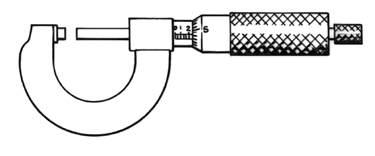
- Micrometer, Eyepiece - A microscope eyepiece with a permanently mounted micrometer scale engraved on glass and permanently mounted in the plane of the diaphragm. The scale must be calibrated against a stage micrometer.
- Micrometer, Stage - A 3" by 1" glass microscope slide in the center of which is ruled a microscopic scale 1 or 2mm long, subdivided into tenths and hundredths of a millimeter or tenths, hundredths and thousands of an inch.
- Microscopic Marks - Striae or patterns of minute lines or grooves in an object. In firearm and toolmark identification these marks are characteristic of the object which produced them and are the basis for identification.
- Milling - Cutting metal by feeding against a rotating cutting tool called a milling cutter; milling machines cut flat surfaces, grooves, shoulders, inclined surfaces, dovetails, and T-slots. Various form-tooth cutters are used for cutting concave forms and convex grooves, for rounding corners, and for cutting gear teeth.
- Minor Diameter - The bore diameter.
- Monocular - A word referring to a single eye (i.e., monocular eyepiece).
- Mushrooming - The act of expansion of a bullet upon impact with a target.
- Musket - A firearm with long barrel and forend or forearm extending nearly to the muzzle. See SMOOTH BORE.
- Matrix - Matrix refers to the work of Mr. Robert H. Kennington in his text “The Matrix: 9MM Parabellum-An Empirical Study of Type Determination," wherein extensive research has been done on class characteristics produced on cartridge cases and bullets.
- Muzzle - The end of a firearm barrel from which the bullet or shot emerges.
- Muzzle brake - A device at or in the muzzle end of a barrel that uses the emerging gas behind the projectile to reduce recoil.
- Muzzle Velocity - The velocity of a projectile as it exits the muzzle of a firearm.
- Muzzle Wave - The air that is compressed and moves out spherically from a firearm's muzzle after firing a projectile.
- NTop
- Needle-fire - An early cartridge system in which the primer is located in the base of the bullet and a long, sharp firing pin pierces the paper or foil case to reach the primer.
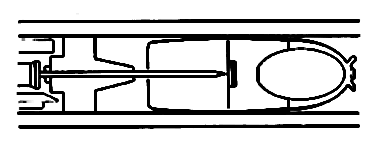
- Nitro Wad - See WAD, NITRO.
- Nitrocellulose - Also known as CELLULOSE HEXANITRATE, the principal ingredient of single-base and double-base gunpowders.
- Nitroglycerin - “Glycerol trinitate" – A high explosive and ingredient of double-base gunpowder.
- Nyclad - An inert nylon jacketing or coating on a lead bullet; a Smith and Wesson original trade name which has been purchased by Federal Cartridge Corporation.
- OTop
- Obturation - 1. The sealing of gases due to the expansion of a cartridge case as a result of chamber pressure.
2. The sealing of gases due to the expansion and/or upset of the bullet base as it travels down the bore. - Ocular - The eyepiece or ocular is designed to further magnify the primary image of the objective of an optical system.
- Ogive - See BULLET, OGIVE.
- Open Base - Jacketed bullet with the core exposed.
- Optics -
1. The study of light and vision.
2. A general term for the components of an optical system. - Overshot Wad - See WAD CARD.
- PTop
- Parkerizing - A nonreflecting, rust-resistant finish used on metal surfaces of some firearms. Also called Phosphatizing or Phosphate Coating.
- Patch - 1. A piece of cloth used with a rod to clean the bore of a firearm.
2. A piece of paper wrapped around a lead bullet to prevent leading of the barrel and to improve the gas seal.
3. In muzzle loading firearms, the piece of cloth surrounding the ball to improve the gas seal. - Pattern Identification - Classification of images into predetermined categories, usually using statistical methods.
- Pattern Matching - The process of determining whether or not the details of striated marks or impressions on two objects correspond, such as fired and unfired cartridge cases and shotshell cases.
- Peen - 1. To stretch, rivet or clinch over by strokes with the peen of a hammer.
2. The rounded end of the head of a ball peen hammer. - Peripheral Milling - In peripheral (or slab) milling, the milled surface is generated by teeth located on the periphery of the cutter body. The axis of cutter rotation is generally in a plane parallel to the workpiece surface to be machined.
- Petard - A medieval term for a small bomb used to blow up gates and walls when breaching fortifications.
- Pinfire - A cartridge system in which a brass pin is installed in the side of the case, the internal tip of the pin resting on a small pocket of fulminate. The hammer falls on the side of the case, driving the pin into the fulminate.
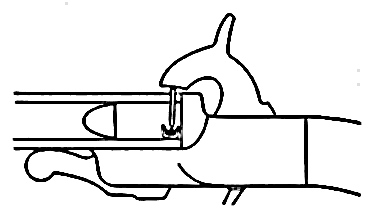
- Planing - Metal-cutting machining in which the workpiece is firmly attached to a horizontal table that moves back and forth under a single-point cutting tool. The tool-holding device is mounted on a crossrail so that the tool can be fed (moved) across the table in small, discrete, sideward movements at the end of each pass of the table.
- Plasticizer - Additive that softens the material to which it is added.
- Plasticizers - Plasticizers are additives that soften the materials (usually a plastic or a concrete mix) they are added to. Although the same compounds are often used for both plastics and concretes, the desired effect is slightly different. The plasticizers for plastics soften the final product increasing its flexibility. From http://en.wikipedia.org/wiki/Plasticizer
- Plated - See Mechanical Plating
- Physical Match - The examination of two or more objects either through physical, optical, or photographic means which permits one to conclude whether the objects were either one entity or were held or bonded together in a unique arrangement. Also called FRACTURE MATCH.
- Polygonal Rifling - See Rifling, Polygonal.
- Potassium Chlorate - Potassium chlorate is a compound containing potassium, chlorine, and oxygen. In pure form, it is a white crystalline substance. It is the most common chlorate in industrial use and is usually present in well-stocked laboratories.
- Powder, Ball - A generally spherical type of smokeless powder first manufactured in 1933 by Western Cartridge Company. Ball powder is often further modified by a flattening process into forms known as FLATTENED BALL, ROLLED BALL, and CRACKED BALL. Ball powder is sometimes found in an elongated form, which is called “irregular ball."
- Powder, Black - The earliest form of propellant, first used for guns in the fourteenth century. It is a mechanical mixture of potassium nitrate or sodium nitrate, charcoal, and sulfur in approximately the following percentages: 75 percent potassium nitrate, 15 percent charcoal, 10 percent sulfur. For sporting arms use, various granulations are available. These are designated “Fg, FFg, FFFg, and FFFFg," largest to smallest, respectively.
- Powder, Tubular - An extruded form of smokeless powder cut into rods whose length normally either equals or exceeds their diameter. Most, but not all examples will have a central perforation and will possess fairly uniform dimensions of length and diameter. The IMR canister powders are all typical examples. Some non-US specimens, however, may have their ends cut on a bias and therefore permit a further distinction.
- Powder Residues - See Primer Residues.
- Press Forging - The mechanical forming by squeezing metal between dies in a press.
- Primer - The ignition component of a cartridge.
- Primer Residues - The components of gunshot residue which contain elements which were originally part of the primer mixture of a cartridge. Neutron Activation Analysis, Atomic Absorption, and Energy Dispersive X-Ray are used to analyze for some of the elements in primer residue, such as antimony and barium. Also known as powder residue.
- Primer Shearing Marks - Striated toolmarks caused by the rough margins of a firing pin hole (aperture) scraping the primer metal during unlocking of the breech of a firearm.
- Priming Charge - See Priming Powder.
- Priming Mixture - A combination of explosive and/or pyrotechnic type of ingredients, which, when pressed into a cup or spun into the rim of a rimfire cartridge, will explode or deflagrate from impact of a firing pin and ignite the propellant in a cartridge or shotshell.
- Priming Powder - Fine grain black powder used to ignite the propellant charge in flintlock and some other early firearms.
- Prism - A transparent body that is bounded by two nonparallel surfaces and is used to alter the direction of a beam of light. An optical instrument employing a prism need not have the objective in line with the eyepiece. Such an instrument would be prismatic.
- Projectile - An object propelled by the force of rapidly burning gases or other means.
- Proof House - Facility/organization to provide (1) a testing and certification service for firearms in order to prove their quality of construction, particularly in terms of the resistance of barrels to explosion under firing conditions, (2) ammunition testing, and (3) firearm accident investigation.
- Proof Test - The firing of a deliberate overload to test the strength of a firearm barrel and/or action. See CARTRIDGE, DEFINITIVE PROOF and CARTRIDGE, PROVISION PROOF.
- Propellant - In a firearm, the chemical composition, which when ignited by a primer, generates gas. The gas propels the projectile(s). Also called POWDER; GUNPOWDER; POWDER, SMOKELESS.
- QTop
- RTop
- Ramp Marks - Abrasions or scratches placed on a bullet through the action of loading a cartridge into a pistol chamber.
- Range of Conclusions Possible When Comparing Toolmarks -
1. IDENTIFICATIONS - Agreement of a combination of individual characteristics and all discernible class characteristics where the extent of agreement exceeds that which can occur in the comparison of toolmarks made by different tools and is consistent with the agreement demonstrated by toolmarks known to have been produced by the same tool.
2. INCONCLUSIVE -
A. Some agreement of individual characteristics and all discernible class characteristics, but insufficient for an identification.
B. Agreement of all discernible class characteristics without agreement or disagreement of individual characteristics due to an absence, insufficiency, or lack of reproducibility.
3. ELIMINATION - Significant disagreement of discernible class characteristics and/or individual characteristics.
4. UNSUITABLE - Unsuitable for microscopic examination. - Ream - To finish a drilled or punched hole very accurately with a rotating fluted tool, called a reamer, of the required diameter.
- Reaming - To widen the opening of (a hole), COUNTERSINK: to enlarge or dress out (a hole) with a reamer, to enlarge the bore of a gun.
- Receiver - The basic unit of a firearm which houses the firing and breech mechanism and to which the barrel and stock are assembled.
- Reference lot - A control sample by which other characteristics are compared.
- Repeating firearm - Any firearm equipped with a magazine that holds more than one shot without reloading.
- Resizing Tool - See Sizing die.
- Reticule - A grid or pattern of posts or lines placed in the focus of a lens which establishes a frame of reference for the measurement of distance or the position of objects viewed through the lens. May consist of intersecting or parallel lines, lines etched into glass, a post or multiple posts, a pinhead dot or any combination of wires, dots and posts of varying sizes and thicknesses. Also called CROSSHAIRS, RETICLE, and, rarely, GRATICULE.
- Revolver - A firearm, usually a handgun, with a cylinder having several chambers so arranged as to rotate around an axis and be discharged successively by the same firing mechanism.
- Ricochet - The deflection of a projectile(s) after impact.
- Rifle - A firearm having rifling in the bore and designed to be fired from the shoulder.
- Rifling (groove) - Helical grooves in the bore of a firearm barrel to impart rotary motion to a projectile.
- Rifling, Polygonal - Lands and grooves having a rounded profile instead of the traditional rectangular profile.
- Rifling methods -
1. BROACH, GANG - A tool having a series of cutting edges of slightly increasing height used to cut the spiral grooves in a barrel. All grooves are cut with a single pass of the broach.
2. BROACH, SINGLE - A nonadjustable rifling cutter which cuts all of the grooves simultaneously and is used in a series of increasing dimensions until the desired groove depth is achieved.
3. BUTTON - A hardened metal plug with a rifled cross-section configuration. It is pushed or pulled through a drilled and reamed barrel so as to cold form the spiral grooves to the desired depth and twist. When the carbide button was first introduced it was described as a SWAGING PROCESS or SWAGED RIFLING.
4. HOOK - A cutting tool which has a hook shape and only cuts one groove at a time.
5. SCRAPE - A cutting tool which cuts two opposing grooves at a time.
6. SWAGE - An internal mandrel with rifling configuration which forms rifling in the barrel by means of external hammering. Also known as HAMMER FORGING. - Rimfire - See CARTRIDGE, RIMFIRE.
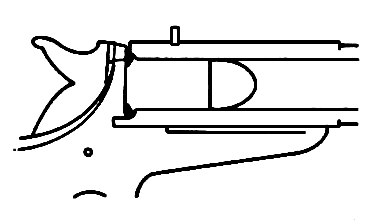
- Rolled crimp - See Crimp, Rolled.
- Rolling Block Action - See ACTION, ROLLING BLOCK.
- Round Nose Bullet - See Bullet, Round Nose.
- Rotary Press - Presses that operate cylinder to cylinder, usually described as rotary presses, consist of two cylinders turning in opposite directions.
- STop
- Sabot - 1. A lightweight carrier in which a subcaliber projectile(s) is centered to permit firing.
2. An enclosure to facilitate the firing of shot usually in a rifled barrel.

- Safety - A device on a firearm generally designed to return to the “on" (safe) position when the firearm is opened.
- Scratch Marks - See Toolmark, Striated.
- Sear - A part which retains the hammer or striker in the cocked position until the trigger is pulled.
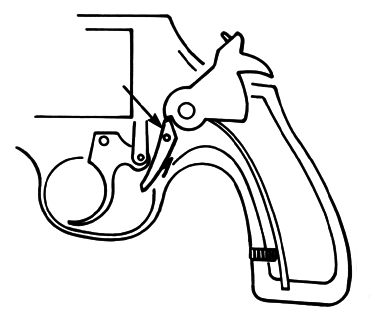
- Semiautomatic - See ACTION, SEMIAUTOMATIC.
- Semifixed ammunition - Artillery ammunition with separate components combined before use.
- Semijacketed - See Bullet, Semijacketed Hollow Point.
- Semijacketed Hollow Point Bullet - See Bullet, Semijacketed Hollow Point.
- Semiwadcutter - See Bullet, Semi-wadcutter.
- Sensitizer - A powdered or fine particulate material that is sometimes used to create voids that aid in the initiation or propagation of the detonation.
- Serrated Jawed Gripping Tools - A gripping tool such as pipe wrenches, slip-joint pliers, lever wrench pliers, etc., whose jaws are serrated for gripping rounded surfaces.
- Set trigger - See TRIGGER, SET.
- Shaping - Shaping and planing operations involve the machining of flat surfaces, grooves, shoulders, T-slots, and angular surfaces with single-point tools.
- Shaving - The cutting of metal from a bullet due to cylinder misalignment in a revolver. Also called Shearing.
- Shear - To cut sheet or bar metal between two blades which pass immediately adjacent to each other.
- Short recoil - A firearm mechanism (action) in which the breechblock remains locked to the barrel only while the pressure is high. This involves a barrel travel of only about one-half inch. The device locking the breechblock to the barrel is then released and the two components separate. The barrel may remain stationary and await the return of the breechblock, but in most modern designs the barrel has its own spring and goes forward into battery.
- Shot, Drop - 1. Lead shot manufactured by the process of pouring molten lead through a colander and allowing the droplets to free-fall into water in a shot tower.
2. Lead shot containing less than 0.5 percent alloying metal. Also called SOFT SHOT. - Shot tower - A tall building in which molten lead alloy is dropped through a colander near the top of the tower into a tank of water at the bottom to produce spherical pellets.
- Shot, Bird - A general term used to indicate any shot smaller than buckshot.
- Shot Collar - A plastic or paper insert surrounding the shot charge in a shotshell to reduce distortion.
- Shot Protector Wad - See Wad, Shot Protector.
- Single-base propellants - A solid propellant based on a single monopropellant usually nitrocellulose in a mixture with stabilizers and plasticizers; used as smokeless powders in ammunition.
- Single-action - An action requiring the manual cocking of the hammer before sufficient pressure on the trigger releases the firing mechanism.
- Single-base - See Single-base propellants.
- Sintered - See Sintering.
- Sintering -The partial fusion of powdered metal under heat and pressure to produce a bullet or pellet. A flux or binder is added to improve adhesion. Typically used for frangible bullets and nontoxic pellets.
- Sizing Die - A tool used to restore fired cartridge cases to their original size by mechanical process.
- Skid Marks - Rifling marks formed on the bearing surface of bullets as they enter the rifling of the barrel before rotation of the bullet starts. Skid marks are typically produced by revolvers and have the appearance of widening of the land impressions at their beginning point. Also called Slippage.
- Slam Fires -The accidental discharge of a firearm upon closing of the action, which may be due to one of the following:
- 1. A firing pin that has stuck and failed to retract
- 2. A primer that is either inadequately seated or overly sensitive
- 3. A weak or broken firing pin retaining spring which fails to overcome the inertia of motion imparted to the firing pin during closure, thereby allowing the firing pin to strike the primer with sufficient force to cause discharge
- 4. A firearm with inadequate headspace
- Slide - A member attached to and reciprocating with the breechblock.
- Slug - A term applied to a single projectile for shotshells.
- Slugging (bore) - A process of determining the interior dimensions of a rifled barrel by measuring a lead ball which has been expanded to fill the bore.
- Smoke - The carbonaceous by-product of burned gunpowder.
- Smoking - A technique using the smoke from a burning magnesium strip to plate or cover a toolmarked surface or bullet to alter its reflective properties.
- Snaphaunce - A particular type of mechanism for firing a gun (or a gun using that mechanism). Like the earlier snaplock and later flintlock, the snaphaunce drives a flint onto a steel to create a shower of sparks to ignite the main charge (propellant).
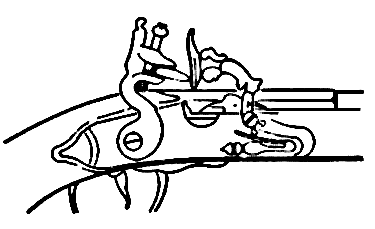
- Sodium Rhodizonate Test - A method of detecting primer and lead bullet residue.
- Soft Point Bullets - See Bullets, Soft Point.
- Solid Base Bullet - See Bullet, Solid Base.
- Spitzer - See Bullet, spitzer.
- Sprue - The opening in a bullet casting mold that permits entry of the molten metal. Also the name given the waste piece cast in this opening.
- Sprue hole - The opening through which the metal is poured into the cope to run into the casting cavity.Credit:
- Stage Micrometer - See Micrometer, Stage.
- Stamping - To cut out, bend, or form with a stamp or die.
- Stellate - Star shaped. In practical use any wound that has three or more points is usually called stellate. For instance a wound in the form of an "L" or a "T" would be called stellate by most.
- Stereo Microscope - An optical instrument, which provides three dimensional viewing of an object through paired objectives and eyepieces. Some models share a common main objective.
- Striae - See Striations.
- Straightened - An operator aims the barrel at an optical pattern on a nearby wall. The pattern design is such that its reflection on the interior surface of the barrel reveals the straightness of the bore, relative to the long axis. If the reflection indicates that the bored hole is not concentric to the axis, the operator places the barrel in a large hand press and applies pressure to points on the barrel that will improve straightness.
- Strain gauge - A simple digital scale is designed to measure force (weight) in only one direction (such as the type normally used by firearm/toolmark examiners). Four strain gauges are fastened to a metal bar or beam inside the scale at points subject to the most deformation by any weight applied to the beam. Force (weight) is normally transmitted mechanically to the beam by placing an object on an external tray mounted on top of a post projecting through the body of the scale to the surface of the beam. The resulting deformation of the beam, however slight, causes a strain to the metal beam and is detected by the strain gauges.More weight produces more strain. Increased strain is detected by the strain gauges, causing a proportional change in the electrical resistance of the gauges. Because the current (amperage) used in the strain gauge is constant, changes in the resistance of the gauges determine the output voltage of the circuitry, which changes in proportion to the weight of the specimen. This output voltage in analog form is converted into a digital signal prior to being fed to the microprocessor, and emerges as information that illuminates the correct portions of the LCD numerical weight readout.
- Striated Toolmarks - See Toolmark, Striated.
- Striations (striae) - Contour variations, generally microscopic, on the surface of an object caused by a combination of force and motion where the motion is approximately parallel to the plane being marked. These marks can contain CLASS and/or INDIVIDUAL CHARACTERISTICS.
- Stripper clips - A clip which may hold from five to ten cartridges and is used to load the magazine of a pistol or rifle. In the case of some rifles, there are clip guides machined into the receiver to guide the clip into the proper position. Also called STRIPPER or CHARGER. See CLIP.
- Subclass Characteristics - Discernible surface features of an object which are more restrictive than CLASS CHARACTERISTICS in that they
- 1. are produced incidental to manufacture,
- 2. are significant in that they relate to a smaller group source (a subset of the class to which they belong),
- 3. can arise from a source which changes over time.
- Submachine guns - A submachine gun is a firearm that combines the automatic fire of a machine gun with the ammunition of a pistol, and is usually between the two in weight and size. They were first experimented with in the form of a stocked pistol being converted from semi- to fully-automatic, in the early 1900s. http://en.wikipedia.org/wiki/Submachine_gun
- Swage - See RIFLING METHODS.
- Swaging - See Barrel Swaging.
- TTop
- Tape primer - A series of fulminating powders placed between two pieces of paper in the form of tape. This is similar to modern cap guns.
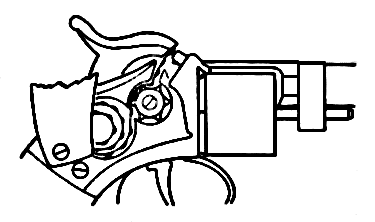
- Taper crimp - A more rounded case mouth for smoother feeding.
- Tartaric Acid - Also called Dihydroxybutanedioic Acid, a dicarboxylic acid, one of the most widely distributed of plant acids, with a number of food and industrial uses. Along with several of its salts, cream of tartar (potassium hydrogen tartrate) and Rochelle salt (potassium sodium tartrate), it is obtained from by-products of wine fermentation.
- Test Firing - The term used to designate the actual firing of a firearm in a laboratory to obtain representative bullets and cartridge cases for comparison or analysis.
- Tetracene - A material used as a sensitizer in priming mixtures.
- Throat - See CHAMBER THROAT.
- Tip Up Pistol - A top-breaking pistol, i.e., Stevens single shot pistols. See TOP BREAK.
- Toolmark, Impressed - The mark produced when a tool is placed against an object and enough pressure is applied to the tool so that it leaves an impression in the object. The class characteristics (shape) can suggest the type of tool used to produce the mark. The individual characteristics can be used to identify the tool with the mark.
- Toolmark, Striated - Marks produced when a tool is placed against another object, and with pressure applied, the tool is moved across the object producing a striated mark. Friction marks, abrasion marks, and scratch marks are terms commonly used when referring to striated marks. These marks can be either class and/or individual characteristics.
- Toolmark Identification - Toolmark identification is a discipline of forensic science which has as its primary concern to determine if a toolmark was produced by a particular tool.
- Toolmarks - See Toolmark, Impressed and Toolmark, Striated.
- Top break - The term used for any firearm on which the barrel or barrels are allowed to tip down at the muzzle exposing the chambers for loading or unloading. See TIP UP PISTOL.
- Total Metal Jacket - Fully encloses a bullet core.
- Touchhole - The vent in muzzleloading guns through which the charge is ignited.
- Tracer Bullet - See Bullet, Tracer.
- Transfer press - An intermediary piece of metal which usually reciprocates with the trigger or hammer of a revolver to transfer the energy of the hammer to the firing pin. When the transfer bar is not in battery with the firing pin, the hammer cannot touch the firing pin. Examples: Ruger New Model Single-Action and Double-Action Revolvers.
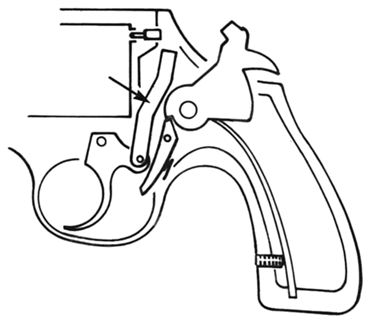 >
> - Trigger - That part of a firearm mechanism which is moved manually to cause the firearm to discharge.
- Trigger Pull - The amount of force which must be applied to the trigger of a firearm to cause sear release. It is measured with hanging weights or an appropriate scale touching the trigger at a point where the trigger finger would normally rest, and with the force applied approximately parallel to the bore axis.
- Trigger, Set - Either a single or double trigger arrangement on which the required trigger pull force can be made very light by means of a “setting" mechanism.
- Truncated Base - See Bullet, Truncated.
- Truncated Bullet - See Bullet, Truncated.
- Tubular Magazines - A tube-shaped magazine in which the cartridges are arranged end-to-end. It may be either under the barrel or in the butt stock.
- Tumble - To clean, smooth, and polish metal parts by placing them in a rotating barrel or drum with abrasive materials.
- Turnbolt action - See Action, Turnbolt.
- Turning - Turning operations involve cutting excess metal, in the form of chips, from the external diameter of a workpiece and include turning straight or tapered cylindrical shapes, grooves, shoulders, and screw threads, and facing flat surfaces on the ends of cylindrical parts.
- UTop
- Ultrasonic Cleaner - An instrument used to clean objects submerged in a detergent or other solution by agitation from high-frequency sound waves.
- Ultrasonic Machining - Material is removed from a workpiece with particles of abrasive that vibrate at high frequency in a water slurry circulating through a narrow gap between a vibrating tool and the workpiece.
- Under-shot Wad - See Wad, Card.
- Unlocking - This is the reverse of the locking process and is frequently performed in conjunction with extraction.
- Upmilling - Mill turn causes teeth to cut with travel; tooth moves "up" through material; the direction of the cutter rotation opposes the feed motion. For example, if the cutter rotates clockwise, the workpiece is fed to the right in up milling. Also called conventional milling.
- Upset Forging - Upsetting involves a flow of the metal back upon itself. An example of this process is the pushing of a short length of a rod through a hole, clamping the rod, and then hitting the exposed length with a die to form the head of a nail or bolt.
- VTop
- Vent - 1. Any hole in the action of a firearm to allow the escape of gases from the breech.
2. A hole in the gas cylinder of a firearm to bleed off gas.
3. Ammunition: see FLASH HOLE.
4. See BARREL VENT. - WTop
- Wad - A plastic, paper, or fiber disk used to keep ammunition components in place or separated. Most commonly associated with shotgun cartridges.
- Wad, Card - A thin card-like disc used in shotshells as OVERSHOT WAD, UNDERSHOT WAD and OVER-POWDER WAD. See "A" in the illustration.
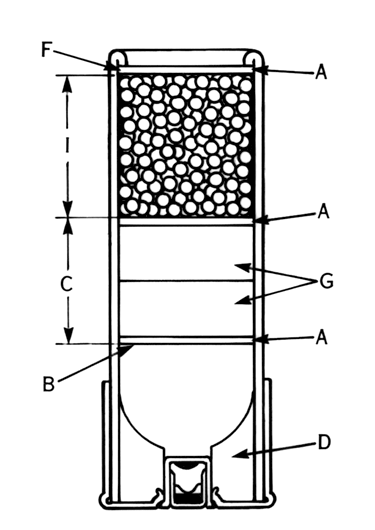
- Wad, Combination - One piece of multipiece plastic wad which may combine the following items: shot protector, filler wad, and overpowder wad.
- Wad, Cup - A powder and shot separator of very shallow cup design, which when loaded with lips down acts to help seal powder gases and so protect the rear of the shot column.
- Wad, Filler - Circular disc of various thicknesses used to adjust the volume of the contents of a shotshell.
- Wad, Nitro - An unlubricated, over-powder wad used with smokeless powder, made of cardboard or felt. Also called NITRO CARD WAD or OVER-POWDER WAD.
- Wad, Shot Protector - Various designs of shot cups made of plastic and designed to reduce pellet deformation during barrel travel.
- Wadcutter Bullets - See Bullet, Wadcutter.
- Washed - See Bullet, Brass Washed and Bullet, Copper Washed.
- Web - 1. The solid portion of a brass centerfire cartridge case between the inside of the case at the head end, and the bottom of the primer pocket.
2. The smallest dimension of a smokeless powder granule. - Wheel locks - Device for igniting the powder in a firearm, such as a musket. It was developed in about 1515. The wheel lock struck a spark to ignite powder on the pan of a musket.
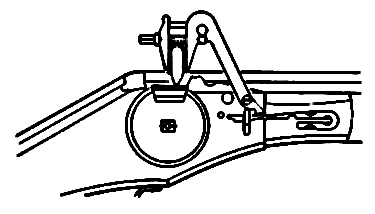
- XTop
- YTop
- ZTop
